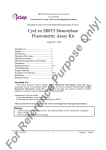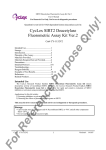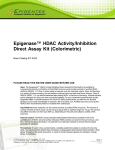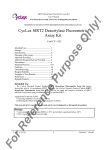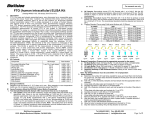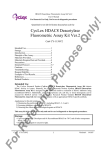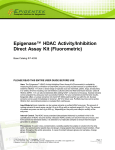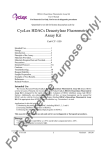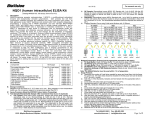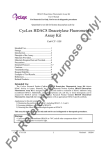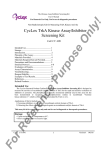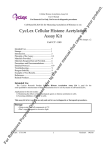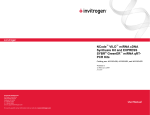Download Data Sheet
Transcript
On ly! SIRT6 Deacetylase Fluorometric Assay Kit Ver.2 User’s Manual For Research Use Only, Not for use in diagnostic procedures Quantitative test kit for NAD-dependent histone deacetylase activity CycLex SIRT6 Deacetylase Fluorometric Assay Kit Ver.2 100 Assays Pu rp Intended Use................................................1 Storage.........................................................1 Introduction..................................................2 Principle of the Assay..................................3 Materials Provided.......................................4 Materials Required but not Provided...........4 Precautions...................................................5 Detailed Protocol.........................................6-8 Troubleshooting...........................................9 Reagent Stability..........................................9 Example of Test Results..............................10-12 References...................................................13 Related Products..........................................14 os e Cat# CY-1156V2 Intended Use ce The CycLex Research Product CycLex SIRT6 Deacetylase Fluorometric Assay Kit detects deacetylase activity of recombinant SIRT6. Primarily, the CycLex Research Product CycLex SIRT6 Deacetylase Fluorometric Assay Kit is designed for the rapid and sensitive evaluation of SIRT6 inhibitors or activators using recombinant SIRT6 or purified SIRT6. en Applications for this kit include: 1) Screening inhibitors or activators of SIRT6. 2) Detecting the effects of pharmacological agents on SIRT6. Storage er This assay kit is for research use only and not for use in diagnostic or therapeutic procedures. rR ef • Upon receipt store #5. Developer and #6. Recombinant SIRT6 at -70°C and all other components below -20°C. • Do not expose reagents to excessive light. Fo Cat#: CY-1156V2 1 Version#: 141107 On ly! SIRT6 Deacetylase Fluorometric Assay Kit Ver.2 User’s Manual For Research Use Only, Not for use in diagnostic procedures Introduction rR ef er en ce Pu rp os e Sir2 is a conserved protein and was recently shown to regulate lifespan extension both in budding yeast and nematode. In 2000, it was reported that the yeast Sir2 protein is a NAD(+)-dependent histone deacetylase that plays a critical role in transcriptional silencing, genome stability and longevity. In mammals, the homologs of Sir2 have been named Sirtuins (SIRTs), with seven members in a family termed SIRT1 through SIRT7. They share a conserved central deacetylase domain but have different Nand C termini and display distinct subcellular localization, suggesting different biological functions (1). The distant mammalian Sir2 homolog SIRT6 is a broadly expressed, predominantly nuclear protein (2) like SIRT1. Inactivation of the Sirt6 gene in mice leads to dramatically shortened life span and a premature aging-like phenotype (3). It was shown that SIRT6 is a histone H3 lysine 9 deacetylase, and identified a role for SIRT6 activity at telomeric chromatin, where it prevents telomere dysfunction in human cells (4). In addition, SIRT6 also deacetylates histone H3 acetylated lysine 56 in vivo to promote genomic stability (5). In term of function, SIRT6 binds to the NF-κB subunit RELA and attenuates NF-κB signaling by modifying chromatin at NF-κB target genes (6). Thus SIRT6-mediated control of NF-κB prevents aging-associated, hyperactive NF-κB-dependent gene expression, and inhibition of NF-κB can rescue the early lethality of Sirt6 knockout mice. Overexpression of wild-type Sirt6, but not the catalytically inactive form, consistently resulted in increased tumor necrosis factor protein production relative to its mRNA levels (7). The conventional method for measuring SIRT6 activity is very complicated and laborious. In order to measure SIRT6 enzyme activity, it is necessary to prepare radioactive acetylated histone H3 as a substrate. First, cells have to be labeled metabolically with radioactivity by adding radioactive acetic acid to the culture medium. Second, radioactive acetylated histone has to be purified from the cells. Following the reaction, it is necessary to extract and separate the radioactive acetyl group, which has been released from acetylated histone, using ethyl acetate to measure the activity of the enzyme based on the radioactivity. Although a method for measuring the activity of deacetylase without the use of radioactive substances was reported in recent years, owing to the use of fluorescent-labeled acetylated lysine as a substrate, the reaction product must be separated from the intact substrate and the fluorescent intensity measured by reverse phase HPLC. As mentioned above, these measurement systems are difficult to adapt for processing many samples under a variety of conditions, because of their complicated operation. Thus a simple system for biochemical analysis as well as for inhibitor screening without the use of radioactive substances is preferred. Fo Cat#: CY-1156V2 2 Version#: 141107 On ly! SIRT6 Deacetylase Fluorometric Assay Kit Ver.2 User’s Manual For Research Use Only, Not for use in diagnostic procedures Principle of the Assay Pu rp os e CycLex SIRT6 Deacetylase Fluorometric Assay Kit measures the activity of SIRT6 by the basic principle of changing a SIRT6 reaction into the activity of the peptidase. In order to measure the enzyme activity of SIRT6, which is the NAD dependent Histone deacetylase, and its homolog, this kit is designed so that the activity of NAD dependent Histone deacetylase can be measured under existence of Trichostatin A, which is the powerful inhibitor of HDACs. In this kit, fluorophore and quencher are coupled to amino terminal and carboxyl terminal of substrate peptide, respectively, and before reaction of deacetylase, the fluorescence cannot be emitted. However, if SIRT6 performs deacetylation, substrate peptide will become cut by the action of peptidase added simultaneously, quencher will separate from fluorophore, and fluorescence will be emitted. Deacetylase enzyme activity is measured by measuring this fluorescence intensity. Since it is very simple to measure and it can be performed at a low price, the measurement of SIRT6 activity in most laboratories is possible if they are equipped with a fluorescent reader for microtiter plates. Considering that the use of fully automatic apparatus to measure fluorescence intensity has become widespread, SIRT6 activity measurement, which could not be made by the conventional method, is now possible with the CycLex SIRT6 Deacetylase Fluorometric Assay Kit using the same equipment. This new method of measurement should dramatically raise the efficiency of inhibitor screening and biochemical analysis of these enzymes. Measuring Principle of The CycLex SIRT6 Deacetylase Fluorometric Assay Kit fluorophore - X-X-X-Lys(Ac) -X-X- quencher ce Deacetylase fluorophore - X-X-X-Lys -X-X- quencher en fluorophore - X-X-X-Lys + Peptidase X-X- quencher er Measurement of fluorescence intensity rR ef *Note: This measuring principle and kit are covered under CycLex’s patents. U.S. Patent No. 7,033,778 and No. 7256013 European Patent No. 1243658 Japanese Patent No. 4267043 Canadian Patent No. 2392711 Fo Cat#: CY-1156V2 3 Version#: 141107 Materials Provided Components of Kit Quantity 1 mL x 2 500 µL x 1 100 µL x 1 500 µL x 1 500 µL x 1 500 µL x 1 1 mL x 2 1 Pu rp Materials Required but not Provided Storage Below -20°C Below -20°C Below -20°C Below -20°C -70°C -70°C Below -20°C Room temp. os e Components #1. SIRT6 Assay Buffer #2. Fluoro-Substrate Peptide (0.1 mM) #3. Fluoro-Deacetylated Peptide (0.1 mM) #4. NAD (8 mM) #5. Developer #6. Recombinant SIRT6 #7. Stop Solution Instruction manual On ly! SIRT6 Deacetylase Fluorometric Assay Kit Ver.2 User’s Manual For Research Use Only, Not for use in diagnostic procedures rR ef er en ce • Microplate for fluorometer • Microplate reading fluorometer capable of excitation at a wavelength in the range 480-500 nm and detection of emitted light in the range 520-540 nm. • Pipettors: 2-20 µL, 20-200 µL and 200-1000 µL precision pipettors with disposable tips. • Multi-channel pipette • Microplate shaker • Deionized water of the highest quality • 500 or 1000 mL graduated cylinder • Reagent reservoirs • Control compound(s) Fo Cat#: CY-1156V2 4 Version#: 141107 On ly! SIRT6 Deacetylase Fluorometric Assay Kit Ver.2 User’s Manual For Research Use Only, Not for use in diagnostic procedures Precautions • Please thaw “#2. Fluoro-Substrate Peptide” and “#3. Fluoro-Deacetylated Peptide” at room temperature before use. Then, thaw the other reagents in ice and use after they are completely thawed. • Please avoid repeated freezing and thawing of “#5. Developer” and “#6. Recombinant SIRT6”. There is a possibility that the enzyme activity may be inactivated. Aliquot to 10-20 µL and store at -70°C. os e • Please avoid mixing of protease/peptidase inhibitors such as PMSF, or alkyl amine in samples that will be measured SIRT6 activity. • Do not use kit components beyond the indicated kit expiration date. • Rinse all detergent residue from glassware. • Do not mix reagents from different kits. Pu rp • Use deionized water of the highest quality. • Do not mouth pipet or ingest any of the reagents. • Do not smoke, eat, or drink when performing the assay or in areas where samples or reagents are handled. • Biological samples may be contaminated with infectious agents. Do not ingest, expose to open wounds or breathe aerosols. Wear protective gloves and dispose of biological samples properly. ce NOTE: THE FOLLOWING PROCEDURES ARE INTENDED ONLY AS A GUIDELINE. THE OPTIMAL EXPERIMENTAL CONDITIONS WILL VARY DEPENDING ON THE PARAMETERS BEING INVESTIGATED, AND MUST BE DETERMINED BY THE INDIVIDUAL USER. rR ef er en For research use only, not for use in diagnostic or therapeutic procedures Fo Cat#: CY-1156V2 5 Version#: 141107 On ly! SIRT6 Deacetylase Fluorometric Assay Kit Ver.2 User’s Manual For Research Use Only, Not for use in diagnostic procedures Detailed Protocol 1. Assay Method for Measurement of SIRT6 Activity os e CycLex SIRT6 Deacetylase Fluorometric Assay Kit can measure the enzyme activity of SIRT6 with a homogeneous method. In this method, the reaction is initiated and the fluorescence intensity is measured by mixing simultaneously fluorescence-labeled acetylated peptide, which is a substrate, SIRT6, NAD and the developer. Since the reaction is not stopped, it is necessary to measure fluorescence intensity at regular intervals after the reaction is initiated, and to determine reaction velocity. Alternatively, within a time in which the reaction velocity is kept constant, it is also possible to stop the reaction by adding stop solution and to measure fluorescence intensity. 1) Following Table.1 below, first, add “Distilled water”, “#1. SIRT6 Assay Buffer”, “#2. Fluoro-Substrate Peptide” and “#4. NAD” to microtiter plate wells. Second “#5. Developer” to each well of the microtiter plate and mix well. Table.1: Reaction mixture for measurement of SIRT6 activity No Enzyme Control Assay 25 µL 5 µL 5 µL 5 µL Positive Control Assay 25 µL 5 µL 5 µL 5 µL No NAD Control Assay 30 µL 5 µL 5 µL - #5. Developer 5 µL 5 µL 5 µL 5 µL Enzyme Sample Buffer of Enzyme Sample #6. Recombinant SIRT6 5 µL - 5 µL - 5 µL 5 µL - 50 µL 50 µL 50 µL Total Volume of the mixture ce Distilled water #1. SIRT6 Assay Buffer #2. Fluoro-Substrate Peptide #4. NAD Pu rp Enzyme Sample Assay 25 µL 5 µL 5 µL 5 µL Assay reagents 50 µL en 2) Initiate reactions by adding 5 µL of your “Enzyme Sample” or “Buffer of Enzyme Sample” or “#6. Recombinant SIRT6” to each well and mixing thoroughly at room temperature. 3) Read fluorescence intensity for 30 to 60 minutes at 1 to 2 minute intervals using microtiter plate fluorometer with excitation at 480-500 nm and emission at 520-540 nm. Measure and calculate the rate of reaction while the reaction velocity remains constant. er Alternate procedure ef 3’) While the reaction rate is kept constant, add 20 µL of “#7. Stop Solution” to each well at appropriate time to stop the reaction, and measure fluorescence intensity in a microplate fluorescence reader capable of excitation at a wavelength in the range 480-500 nm and detection of emitted light in the range 520-540 nm. rR Note-1: During the time in which SIRT6 reaction rate is maintained, the difference in fluorescence intensity between “Enzyme Sample Assay” and “No Enzyme Control Assay” indicates the SIRT6 activity of your “Enzyme Sample”. Fo Cat#: CY-1156V2 6 Version#: 141107 On ly! SIRT6 Deacetylase Fluorometric Assay Kit Ver.2 User’s Manual For Research Use Only, Not for use in diagnostic procedures Note-2: Although the volume of addition of “Enzyme Sample” or “Buffer of Enzyme Sample” or “#6. Recombinant SIRT6” is set to 5 µL in Table.1, it may be changed to a volume up to 20 µL at your discretion. In that case, please reduce the volume of “Distilled water” to set the final reaction volume of 50 µL. Note-3: If enzyme samples contain some protease/peptidase able to break down “#2. Fluoro-Substrate Peptide”, resulting in an increase of fluorescence intensity in “No NAD Control Assay”, the SIRT6 activity in the samples cannot be evaluated correctly. os e Note-4: If enzyme samples contain inhibitors for protease/peptidase, precise SIRT6 enzyme activity cannot be measured. Since protease/peptidase inhibitors used in the usual protein purification process strongly inhibit the peptidase activity in the development reaction, please avoid using any protease/peptidase inhibitors during the process of protein purification. Note-5: If enzyme samples have an inhibitory effect on the peptidase in the development reaction, the final fluorescence intensity will not increase. Please use “#3. Fluoro-Deacetylated Peptide” instead of “#2. Fluoro-Substrate Peptide”, and conduct a control experiment. Pu rp 2. Assay Procedures for Inhibitor/Activator Screening 1) Following Table.2 below, first, add “Distilled water”, “#1. SIRT6 Assay Buffer”, “#2. Fluoro-Substrate Peptide” or “#3. Fluoro-Deacetylated Peptide” and “#4. NAD” to microtiter plate wells. Second, add “Test Compound” or “Solvent of Test Compound” or “Control Compound (not provided)”, and “#5. Developer” to each well of the microtiter plate and mix well. Table.2: Reaction mixture for inhibitor/activator screening Assay reagents Test #5. Developer er #6. Recombinant SIRT6 (or Enzyme Sample) Solvent Control Assay 20 µL 5 µL 5 µL 5 µL 5 µL - Control Compound Assay 20 µL 5 µL 5 µL 5 µL 5 µL No Enzyme Control Assay 25 µL 5 µL 5 µL 5 µL 5 µL - Development Control Assay 30 µL 5 µL 5 µL 5 µL - 5 µL 5 µL 5 µL 5 µL 5 µL 5 µL 5 µL 5 µL - - 50 µL 50 µL 50 µL 50 µL 50 µL en Distilled water #1. SIRT6 Assay Buffer #2. Fluoro-Substrate Peptide #3. Fluoro-Deacetylated Peptide #4. NAD Test Compound Solvent of Test Compound Control Compound (not provided) Test Compound Assay 20 µL 5 µL 5 µL 5 µL 5 µL - ce Assay reagents ef Total Volume of the mixture 2) Initiate reactions by adding 5 µL of “#6. Recombinant SIRT6” (or your “Enzyme Sample”) to each well and mixing thoroughly at room temperature. rR 3) Read fluorescence intensity for 30 to 60 minutes at 1 to 2 minute intervals using microtiter plate fluorometer with excitation at 480-500 nm and emission at 520-540 nm. Measure and calculate the rate of reaction while the reaction velocity remains constant. Fo Cat#: CY-1156V2 7 Version#: 141107 On ly! SIRT6 Deacetylase Fluorometric Assay Kit Ver.2 User’s Manual For Research Use Only, Not for use in diagnostic procedures Alternate procedure 3’) While the reaction rate is kept constant, add 20 µL of “#7. Stop Solution” to each well at appropriate time to stop the reaction, and measure fluorescence intensity in a microplate fluorescence reader capable of excitation at a wavelength in the range 480-500 nm and detection of emitted light in the range 520-540 nm. os e Note-1: During the time in which SIRT6 reaction rate is maintained, the difference in fluorescence intensity between “Solvent Control Assay” and “No Enzyme Control Assay” indicates the SIRT6 activity. Pu rp Note-2: In order to estimate the active or inhibitory effect on SIRT6 activity by the test compounds correctly, it is necessary to conduct the control experiment of “Solvent Control Assay” at least once for every experiment and “Control Compound Assay” at least once for the first experiment, in addition to “Test Compound Assay” as indicated in the Table.2. When test compounds cause an active or inhibitory effect on SIRT6 activity, the level of increase of fluorescence intensity is strengthened or weakened as compared with “Solvent Control Assay”. Note-3: The efficacy of the test compounds on the SIRT6 activity is the difference in fluorescence intensity between [“Test Compound Assay” minus “No Enzyme Control Assay”] and [“Solvent Control Assay” minus “No Enzyme Control Assay”]. Note-4: If test compounds have an inhibitory effect on protease/peptidase, resulting that the increase in fluorescence intensity is not or a little observed in “Development Control Assay”, the effect on SIRT6 activity cannot be evaluated correctly. ce Note-5: Although the above tables indicate the volume of addition of “Test Compound” or “Solvent of Test Compound” or “Control Compound (not provided)” as 5 µL, the concentration and the volume of the reagents to add can be changed so that the concentration of test compounds becomes the setting concentration. For example, since the final volume of reaction is 50 µL here, it is also possible to add 10 µL of “Test Compound” or “Solvent of Test Compound” or “Control Compound (not provided)”. In this case, please reduce the volume of “Distilled water” to set the final reaction volume of 50 µL. rR ef er en Note-6: Although the volume of addition of “Recombinant SIRT6” or your “Enzyme Sample” is set to 5 µL in above tables, it may be changed to a volume up to 20 µL at your discretion. In that case, please reduce the volume of “Distilled water” to set the final reaction volume of 50 µL. Fo Cat#: CY-1156V2 8 Version#: 141107 On ly! SIRT6 Deacetylase Fluorometric Assay Kit Ver.2 User’s Manual For Research Use Only, Not for use in diagnostic procedures Troubleshooting 1. When chemicals that have an inhibitory effect on the peptidase are mixed in a crude SIRT6 fraction purified from various cells or the immunoprecipitate using a specific antibody against SIRT6 or other proteins, precise SIRT6 enzyme activity cannot be measured. Since the protease/peptidase inhibitors used in the usual protein purification process inhibit the peptidase activity strongly, please avoid the use of any protease/peptidase inhibitors during the protein purification process. os e 2. Final fluorescence intensity will not increase, both when test chemicals have an inhibitory effect on SIRT6, and also when there is an inhibitory effect on the peptidase. 3. If the test reagents themselves emit fluorescence at excitation wavelength: 480-500 nm and fluorescence wavelength: 520-540 nm, the inhibitory effect of the test assay cannot be evaluated correctly. Pu rp 4. The recombinant SIRT6 should be run in duplicate, using the protocol described in the Detailed Protocol. Incubation times or temperatures significantly different from those specified may give erroneous results. 5. The reaction curve is nearly a straight line if the kinetics of the assay is of the first order. Variations in the protocol can lead to non-linearity of the curve, as can assay kinetics that are other than first order. For a non-linear curve, point to point or quadratic curve fit methods should be used. 6. Poor duplicates indicate inaccurate dispensing. If all instructions in the Detailed Protocol were followed accurately, such results indicate a need for multi-channel pipettor maintenance. Reagent Stability rR ef er en ce All of the reagents included in the CycLex Research Product CycLex SIRT6 Deacetylase Fluorometric Assay Kit have been tested for stability. Reagents should not be used beyond the stated expiration date. Upon receipt, store the “#5. Developer” and “#6. Recombinant SIRT6” at -70°C, all other kit reagents should be stored below -20°C. Fo Cat#: CY-1156V2 9 Version#: 141107 On ly! SIRT6 Deacetylase Fluorometric Assay Kit Ver.2 User’s Manual For Research Use Only, Not for use in diagnostic procedures Example of Test Results Fig.1 Dose dependent curve of recombinant SIRT6 activity Dose dependent curve 2,000 os e 1,500 1,000 500 0 0.00 Pu rp RFU (F535/F485 x10 -3 ) 50 min. 25 min. 10 min. 5 min. 0.50 1.00 SIRT6 (µg) 1.50 Fig.2 Time course of SIRT6-substrate deacetylation by recombinant SIRT6 Time course 2,000 1,000 500 en 1,500 er RFU (F535/F485 x10 -3 ce ) 1.5 µg 0.75 µg 0.38 µg 0.19 µg 0 µg ef 0 rR 0 Fo Cat#: CY-1156V2 10 20 30 Reaction time (min.) 10 40 50 Version#: 141107 On ly! SIRT6 Deacetylase Fluorometric Assay Kit Ver.2 User’s Manual For Research Use Only, Not for use in diagnostic procedures Fig.3 NAD dependency of recombinant SIRT6 activity NAD dependency 2,000 os e 1,500 1,000 500 0 0 10 Pu rp RFU (F535/F485 x10 -3 ) 800µM 400µM 200µM 100µM 0µM 20 30 reaction time (min.) 40 50 Fig.4 Effect of Trichostatin A and NAD on recombinant SIRT6 activity ce 40,000 35,000 25,000 20,000 15,000 10,000 en 30,000 er Reaction velocity (RFU/min.) 45,000 5,000 rR ef 0 Fo Cat#: CY-1156V2 NAD (+) NAD (-) NAD (+) NAD (-) TSA (+) TSA (-) 11 Version#: 141107 Fig.5 Effect of several compounds on recombinant SITR6 activity Effect of several compounds on SIRT6 activity 80 40 os e 60 Sirtinol Resveratrol 20 Quercetin 0 Pu rp 0 200 400 600 Test compound (µM) 800 1,000 rR ef er en ce SIRT6 activity (% vehicle control) 100 On ly! SIRT6 Deacetylase Fluorometric Assay Kit Ver.2 User’s Manual For Research Use Only, Not for use in diagnostic procedures Fo Cat#: CY-1156V2 12 Version#: 141107 On ly! SIRT6 Deacetylase Fluorometric Assay Kit Ver.2 User’s Manual For Research Use Only, Not for use in diagnostic procedures References 1. North, B.J., and Verdin, E.; Sirtuins: SIRT6-related NAD-dependent protein deacetylases. Genome Biol. 5: 224, 2004 2. Michishita E et al.; Evolutionarily conserved and nonconserved cellular localizations and functions of human SIRT proteins. Mol Biol Cell. 16: 4623, 2005 os e 3. Mostoslavsky R et al.; Genomic instability and aging-like phenotype in the absence of mammalian SIRT6. Cell. 124: 315, 2006 4. Michishita E et al.; SIRT6 is a histone H3 lysine 9 deacetylase that modulates telomeric chromatin. Nature. 452: 492, 2008 5. Yang B et al.; The sirtuin SIRT6 deacetylates H3 K56Ac in vivo to promote genomic stability. Cell Cycle. 8: 2662, 2009 Pu rp 6. Kawahara TL et al.; SIRT6 links histone H3 lysine 9 deacetylation to NF-kappaB-dependent gene expression and organismal life span. Cell. 136: 62, 2009 rR ef er en ce 7. Van Gool F, et al.; Intracellular NAD levels regulate tumor necrosis factor protein synthesis in a sirtuin-dependent manner. Nat Med. 15: 206, 2009 Fo Cat#: CY-1156V2 13 Version#: 141107 On ly! SIRT6 Deacetylase Fluorometric Assay Kit Ver.2 User’s Manual For Research Use Only, Not for use in diagnostic procedures Related Products Pu rp os e * CycLex Cellular Histone Acetylation Assay Kit: Cat# CY-1140 * CycLex HDACs Deacetylase Fluorometric Assay Kit Ver.2: Cat# CY-1150V2 * CycLex SIRT1/Sir2 Deacetylase Fluorometric Assay Kit Ver.2: Cat# CY-1151V2 * CycLex SIRT2 Deacetylase Fluorometric Assay Kit Ver.2: Cat# CY-1152V2 * CycLex SIRT3 Deacetylase Fluorometric Assay Kit Ver.2: Cat# CY-1153V2 * CycLex SIRT6 Deacetylase Fluorometric Assay Kit Ver.2: Cat# CY-1156V2 * CycLex HDAC8 Deacetylase Fluorometric Assay Kit Ver.2: Cat# CY-1158V2 * Anti-Acetylated Histone/p53-K382 Mouse Monoclonal Antibody: Cat# CY-M1029 * Anti-Histone Deacetylase 1 (HDAC1) Rabbit Polyclonal Antibody: Cat# CY-P1011 * Anti-Histone Deacetylase 2 (HDAC2) Rabbit Polyclonal Antibody: Cat# CY-P1012 * Anti-Human SIRT1 Rabbit Polyclonal Antibody: Cat# CY-P1016 * NAD(+)-Dependent Deacetylase SIRT1: Cat# CY-E1151 * NAD(+)-Dependent Deacetylase SIRT2: Cat# CY-E1152 * NAD(+)-Dependent Deacetylase SIRT3: Cat# CY-E1153 * NAMPT (Nicotinamide Phosphoribosyltransferase): Cat# CY-E1251 * NMNAT1 (Nicotinamide Mononucleotide Adenylyltransferase 1): Cat# CY-E1252 ce Note: This product is covered under CycLex’s patents. U.S. Patent No. 7,033,778 and No. 7256013 European Patent No. 1243658 Japanese Patent No. 4267043 Canadian Patent No. 2392711 en PRODUCED BY er CycLex Co., Ltd. 1063-103 Terasawaoka Ina, Nagano 396-0002 Japan Fax: +81-265-76-7618 e-mail: [email protected] URL: http://www.cyclex.co.jp rR ef CycLex/CircuLex products are supplied for research use only. CycLex/CircuLex products and components thereof may not be resold, modified for resale, or used to manufacture commercial products without prior written approval from CycLex Co., Ltd.. To inquire about licensing for such commercial use, please contact us via email. Fo Cat#: CY-1156V2 14 Version#: 141107














